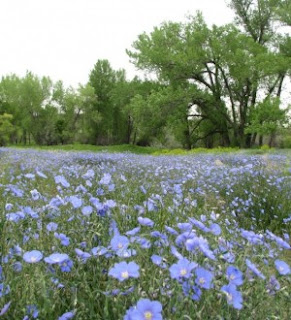 Blue flax is practically a weed wherever it grows. It's very pretty (love that blue color!), it's tough and drought-tolerant, and it reseeds by the bajillions, which makes it almost noxious in Laramie.
Blue flax is practically a weed wherever it grows. It's very pretty (love that blue color!), it's tough and drought-tolerant, and it reseeds by the bajillions, which makes it almost noxious in Laramie. Except for on the green roof.
We planted 32 individual plants of blue flax (Linum lewisii) on the roof in June of 2011. They all survived into summer of 2012. Then the epic green roof fiasco happened, and we moved them from the roof to the golf course and back again.
Once spring 2013 rolled around... they were gone. Poof. Shazam. What the?
About Blue Flax
 From the book High and Dry: Gardening with Cold-Hardy Dryland Plants (Robert Nold, 2008):
From the book High and Dry: Gardening with Cold-Hardy Dryland Plants (Robert Nold, 2008):"Linum lewisii is a common plant, found throughout the west (Alaska to Mexico), in various habitats. Linear green leaves on stiff wiry stems to a foot or so... carry a profusion of clustered blue flowers. Probably best for the wild garden: L. lewisii does seed about furiously."
From the book Wildflowers of Wyoming (Diantha and Jack States, 2004):
"Blue flax has sky blue petals with white or yellowish bases. The flowers occur on slender, waving stems. Leaves are linear and about 1 inch long. Named in honor of Meriwether Lewis, this plant was first collected for science on the Lewis and Clark expedition in 1805. It is found throughout western North America and is common in all vegetation zones."
Why Wont It Grow?
According to the Natural Resources Conservation Service's plant guide (access here), blue flax grows splendidly on pretty crummy (infertile, disturbed, somewhat salty or acidic), well-drained soils. It is winter and drought hardy. It tolerates lots of sun but can be in some shade (where we planted it in the southwest corner of the roof has some shade).
 |
| The site of the missing flax |
Now if that all doesn't describe the green roof, I don't know what does. It's a mystery. A cold case. The lack of blue flax is absolutely perplexing.
Do any of you have ideas? If so, share them below!
Written by Brenna Marsicek, Biodiversity Institute
Well, what about heat? Glass and rocks, dirt is more than likely hotter then out in the open! The fact the area is lightly colored, is not - a good absorber of light - most likely not have had an impact on the heat-damage caused by the concentrated heat.
ReplyDeleteYou could coat the windows to reduce reflection - which would be a cheap fix - but the downside of that is it could reduce the light entering the building. (IEQ)
Reports across the country have alleged damages brought on by concentrated sunlight reflected off of energy efficient windows to the point of melting car parts! So how about a shaded cover to get the plants going?
Robert Haverlock
Certified Sustianable Building Consultant
My flax have been doing the same thing in my yard for years, save that they volunteer/reseed themselves in areas that they like. Not one plant that I've put in myself has survived more than a season or two. The plants that seed themselves do much better over time; they also tend to spring up at the edges of sidewalks, garden edging, rocks, or anywhere that the roots can anchor themselves slightly under something. I wonder if this might be more about getting a bit more water, which pools in such areas, then just mooring themselves. They volunteer in these areas even though they are hotter, sunnier, have less amended soils, and are drier overall (e.g., next to a driveway, which is way hotter than my flower beds). But I have found that I cannot control where the flax plants want to grow --they find their own desired areas.
ReplyDelete